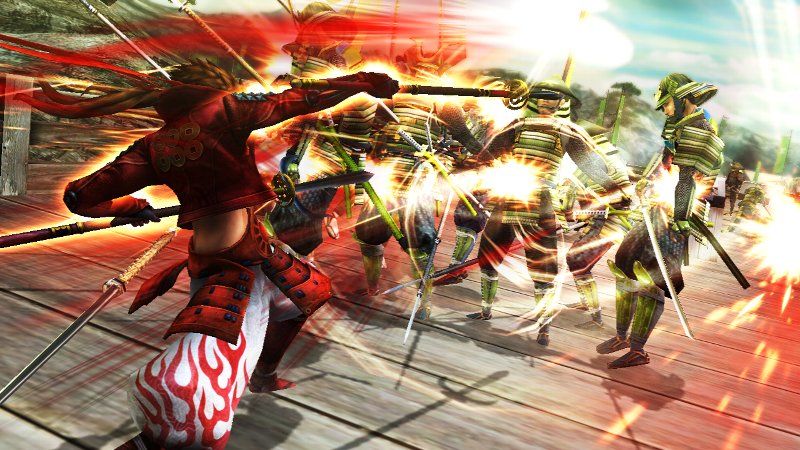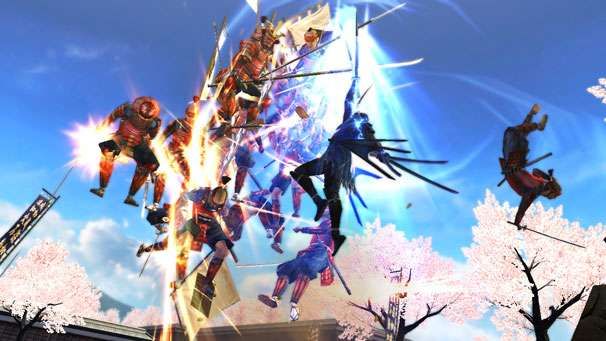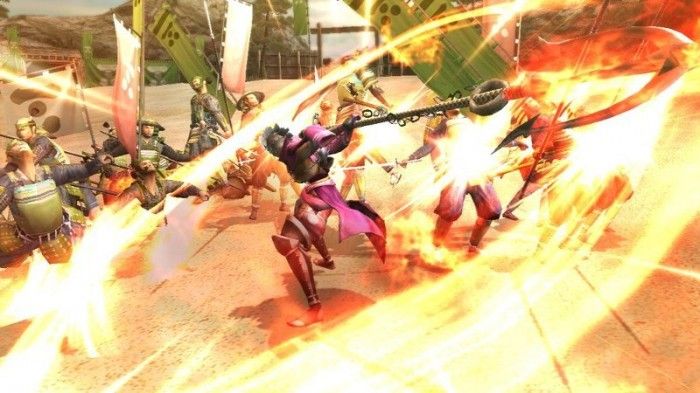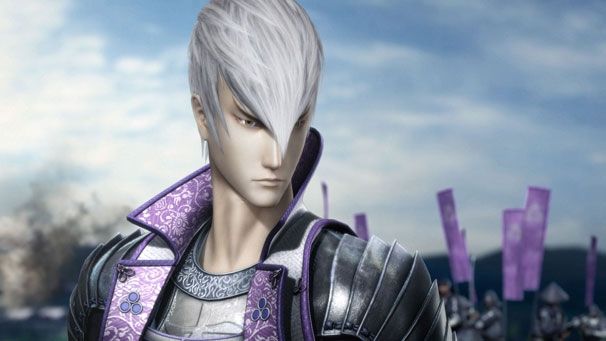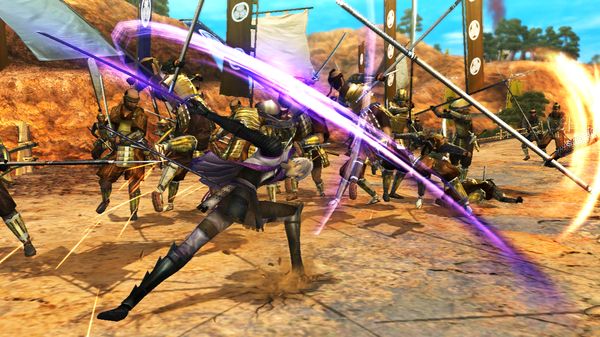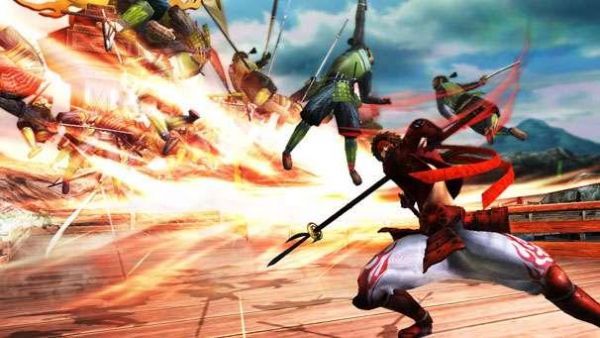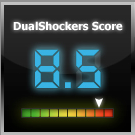Sengoku Basara: Samurai Heroes is the latest in a very popular series of tactical action games over in Japan. The series isn’t too fond of American releases, the only one besides this game being Devil Kings which hit the PlayStation 2 in 2005.
The series has spawned numerous Japanese iterations, including a 2D fighting game by masters of the genre, AKSYS, who also published my darling BlazBlue series. Having never played any of the games until now, I wasn’t sure what to expect, because as we all know, what’s popular overseas isn’t always so popular in the States.
After having played the game extensively, I must say I had a good time with it. Let’s kick this off with a little bit of the game’s history. I had been watching Sengoku Basara for a good while now, interested in its hack and slash nature and stylish looking combat.
Being a big fan of games like Devil May Cry and Ninja Gaiden, this wasn’t surprising. I’m sure you recall how pleased I was with the demo in the game’s impression. Recently at the New York City ComicCon, Capcom was among the most relevant of game spaces on the show floor. The Sengoku Basara booth maintained a considerable line, which was clearly because the combat was so stylish and appealing. I spent a good amount of time there and even collected some of the best swag: a Sengoku Basara flag and matching t-shirt.
Moving on, the game is awesome and has an interesting premise. You are placed smack in the middle of the Warring States period of Japanese history. The recollection is a little loose in some spots and isn’t to intriguing if you’ve played games such as Dynasty Warriors or Samurai Warriors before.
To be truthful though, I’ve played just about all of those and I fail to remember the historical figures ever being represented in such trendy or stylish ways. The story is a little bit of a mess and from the very beginning implies that the player have some previous knowledge of the series or its lore.
The biggest problem, like I said in the beginning, is that this is one of only two games in the series to have ever been released in North America, so how could they have expected us to know anything about the characters’ history? It isn’t too upsetting though. Games like this always have a terrible time conveying story to the players because there are always so many different characters and they often refuse to focus on just one specific character or set of characters or events.
That being said, it is very interesting to think that the majority of this stuff is based on actual history and you may find yourself spending several hours on Wikipedia learning about it. From what I can tell, the “main characters,” should you be able to identify them, are Mitsunari Ishida and Ieyasu Tokugawa. They’re the purple and yellow guys on the games case. Basically, Mitsunari Ishida was the servant of a powerful general known as Toyotomi Hideyoshi. Ieyasu subsequently killed Toyotomi in an effort to unite the states and stop all the fighting by…fighting.
Mitsunari then alleged to gaining vengeance and seeking out Ieyasu and so on and so forth. Apparently this isn’t exactly how things transpired in literal history, but this is still a video game so who gives a crap? This story is only one of several interweaving stories between the various factions and characters and it all has the propensity to be incredibly confusing.
I simply took this as the main story, since Ieyasu is clearly the main character and everyone besides Mitsunari seemed to only want to ally with him. You should know that each of the sixteen playable characters has their own story mode and they are all long and filled out.
It should take about six to seven hours to fully complete each story and when I say fully complete, I mean 100%. You see, when you beat the story mode you unlock a new costume, a new title, a trophy and various other things, but this isn’t technically the end of the story. You can go back, sort of like a new game plus feature, and play through the remainder of the Japanese map, yielding more story completion. I think that the reason that you unlock things at the actual half way point of the story instead of upon 100% completion is because this would be a long, arduous task that many people would probably not bother completing. Sixteen times the average of six equals ninety-six. So you’ll spend at least ninety six hours fully completing each characters story. It is really long and drawn out, but more on that later.
Let's move on to the presentation. The cut scenes in the game are done well and the general rendering of everything is tight, but it isn’t mind blowing. Hordes of samurai fodder aren’t too detailed and all look the same but this isn’t something you’ll be concerned with. The environments aren’t too technically impressive, but they’re all designed well which makes up for it. Many of the levels are portrayed finely and it’s enthralling when you’re pitted in battles at exciting locations that actually existed once.
Each playable character is depicted with a nice level of detail, and they all manage to look unique and interesting enough. Just about all of the characters possess a certain emo quality that makes them look as though they’re going to break into Japanese grunge rock at any moment, which is cool if that’s your thing.
Speaking of music, it really handles itself well in this game. The soundtrack consists of a sloppy mix of orchestral arrangements and punk rock numbers. The rock is subpar and not very noticeable, so I guess I have to say I disliked it. The classical pieces though were exceptional. Most utilized Asian instruments, such as the erhu, came together satisfyingly though I can’t honestly say I’d pursue the soundtrack.
Everything is wrapped up in a nice package, but what about the contents? The gameplay? I found it pleasant. Gameplay basically consists of combat, material/weapon looting, money collecting and item crafting. Let’s start with the combat. Remember earlier when I mentioned Samurai and Dynasty Warriors? Combat in either of those series can’t hold a flame to the over-the-top insanity in Sengoku Basara’s combat, especially when the majority of combat in those others consisted of running around mashing a single button until you filled a special attack meter. It’s true that this game also makes use of a special attack meter, but you’ll be doing a lot more than button mashing to fill it in this game.
Each character has a variety of attacks, normally between four and five, in addition to their standard combo. They also unlock super arts, which are attacks stronger than standard arts and not as strong as special arts. You may unlock up to three of these and only equip one.
To further the functionality of these multiple attacks, they level up after a certain number of uses, increasing their strength and effects. It doesn’t stop there - you can guard, parry and recover, giving you great defensive options. This setup is easily superior to the combat in any of the aforementioned games, no contest.
I sped through chaining combos and attacks like I was playing Devil May Cry, and this added volumes to the game for me. In fact, this game is almost shockingly similar to DMC4 in some ways, which isn’t surprising, considering the similar lineage. Fighting in the game was never a chore the way it was in Dynasty Warriors. Roaming around mashing on a single button until the special filled was terribly boring and killed most of those games for me. Luckily, this game provides the depth of combat I so enjoy, while allowing my brother to mash to his heart’s content.
There are two meters that you should worry about filling this time around. One is your standard special meter which basically fills as you haul behind allowing you to eventually pull off a flashy finishing move and remain invincible all the while. A second meter, the hero gauge, fills as you execute your foes with style.
I knew the hero gauge responded to combos and style because mine filled repeatedly while it took my brother ages to fill one. When activated, the hero gauge initiates a slow motion mode which allows you to decimate enemies and gives them no chance to recover. As I understand it, using your special during hero time will activate some sort of super special and I did this often though I could see very little noticeable differences between the two specials. Perhaps it applied to damage. You are encouraged to knock your foes into the air and then jump to continue your assault.
If only the enemies were as durable and challenging as in DMC. Basically, they’re terrible. The AI is just awful, sad and possibly one of my biggest gripes with the game, period. Huge groups of samurai race towards you, brandish their weapons and just stand there. It’s so irritating, especially when you’re trying to feel cool and stylish. I mean, who cares if I just killed that guy with a fifty hit combo when he didn’t even attempt to defend himself?
This is even noticeably more terrible in your allies. When you play single player instead of co-op, you get an AI ally to help you fight. Honestly, I would rather play alone than have that sorry excuse for a partner following me around the entire time. They do nothing, absolutely nothing. They fight even less than the enemy, which is saying a whole lot. At first you think it’s okay since you can actually level your allies up. They have a confidence bar which fills as you win battle after battle with your desired ally equipped, but even fully leveled they still just walk in menacing circles around the enemy.
They are most helpful when you activate your special art. If they’re near you at the time, they’ll also activate theirs but this is without a doubt the most functionality you’ll get out of them. They even have these special abilities like burning enemies or added money, but they matter little when all they do is stand by watching you fight.
This really puzzled me because your allies put in work when you leveled them up on Dynasty Warriors. If you die, and this will probably never happen on normal or (God forbid) easy, you must start from the very beginning. The game makes no use of checkpoints or the like, and it will suck on hard mode.
The developers have thrown in lots of things to make the general task of combat much more entertaining. Various power-ups like increased attack or extra money for each attack landed scatter the battlefield, mixing things up. You can also find health, basara (special) meter bonuses and even materials in boxes that lay around the stages.
You will also randomly encounter fugitives. You get rewards for capturing fugitives, but it’s not easy to do as they are usually quite formidable and hard to defeat. Gameplay is broken up into wars. Winning a war is simply defeating the boss of the stage, but you can find more fun than that if you so choose.
Each stage is littered with enemy bases which you can claim by defeating the generals. There are a few reasons you might wish to do this. For one thing, you get special rewards for taking over the map as opposed to just beating the boss. For another thing, groups spawn at bases. Whether it’s an ally or an enemy group depends on who is in control of it. In this way, the bases create the feeling that there is a war taking place around you, whether you fight in it or not. Groups spawn at bases and branch out across the map battling other groups of enemies. If you don’t own enough bases, the enemy will constantly overtake your groups and reclaim their bases.
All this adds a light tactical garnish to things. Speaking of tactics, the game gives you a little room for true strategy. In many stages there are traps that slow down progression and damage you and your allies. For example, one stage utilized a thick mist that kept us from seeing clearly until we defeated all the generals operating the mist machines.
You will also come across alternate paths across the stages like zip lines, which may put you behind the enemy for a preemptive strike or transport you to otherwise inaccessible areas. Even more strategy is the ability to pick and choose your battles from time to time. These decisive battles affect the outcome of a character’s particular arc and may result in new allies or unions. They also allow you to avoid replaying stages you didn’t find interesting when you played them in a different character’s story. The stages or wars are reused throughout the various stories, which are okay since they’re not bad and also because there are still about forty of them altogether, but don’t quote me on that.
Many of the boss enemies are playable characters but then, just as many are not. I just hate awesome non-player characters, it doesn’t make since to me. Looting materials is a fun but time consuming pastime that was thrown in for added depth. Basically, there are lots and lots of accessories in the game. These accessories are attached to weapons and possess a range of effects. Some increase attack and defense power, special art strength and hero gauge speed all the way to increased money, experience and strengthened elemental effects. Frankly, you’ll get the most out of the game by utilizing these accessories. You could go through without ever making use of one, but where’s the fun in that?
Anyway, you can purchase a few lower level accessories from the item mart, but for nearly all of the accessories, you’ll need to collect materials and money. Materials are dropped from leaders and bosses throughout the game. Each awesome accessory requires a set amount of materials and money to create. I found it a little bit odd that you needed money and materials to make accessories, but guessed that it was added as a balancing element. Anyway, many materials are exclusive to certain stages, which means you’ll have to play through as many as you can to get the materials for the accessories you want.
Furthermore, if you want all the accessories, which is a trophy of some sort, you’ll have to play through all the stages multiple times. It is a daunting and epic idea, and the game manages this same emotion in various ways. Material collecting is fun, but to be honest, I’m not sure I’d still care by the time I’ve played through all the stages multiple times.
Weapons have different numbers of accessory slots, so the stronger the weapon is, the more slots it has and the more accessory effects you can stack. From what I could tell, each character has about four weapons which are unlocked as you complete their stories.
Co-op is downright fun. You and a friend can jump into the action and take on the hordes together. Both of your attacks contribute to the same combo counter which is awesome for stringing hits together. You can also revive your ally and vice versa in the event that one of you die. It is miles better than playing with a garbage ally and almost makes the single player experience seem inferior by comparison.
It also rocks that you can take your leveled up character into the co-op modes, meaning your level forty partner can help out your level one if you choose to play on hard to jumpstart his progression. It is really fun, but everyone doesn’t have access to an additional player.
Quick battle mode allows you to tackle any specific war you’ve been in which is useful if you need to collect more of a certain material. A gallery mode allows you to view character information and cut scenes in an effort to bring together the impossibly hard to follow story, as well as other amenities like music.
As far as value, this game will take a long, long time to fully complete. It will take so long to complete that I fear even the most devote fan may lose interest at some point. Not that this displeases me, since more for your money is always good. It depends on how you feel about the game. If you love the combat, like I do, then you don’t mind the idea of playing until you fingers blister. But, if you don’t like it so much and you just want the trophies, or to know everyone’s stories, prepare to dedicate yourself. I could easily see total completion running well over one hundred, maybe even two hundred hours. Too bad they didn’t include anyway to see how long you’ve been playing.
This game may only be forty dollars, but I’d wager that it is more content rich than the most of the full priced games dropping right now. In conclusion, I really liked Sengoku Basara: Samurai Heroes. It is tons of fun to play, has tons of unlockables and will keep you playing for a ridiculously long time.
My complaints are very minor: the AI is deaf, dumb and blind, some rock tracks are totally bleh, and a few more weapons and special arts per character wouldn’t have hurt. The story is also a bit of a mess and I don’t see how they forgot some sort of clock to let you know how long you’ve played.
That being said, it has lots of characters, stylish, satisfying combat, lovely instrumental tracks, competent character progression, challenging trophies and goals, strategic gameplay, a wealth of collectibles, intriguing historical fiction, Japanese anime/manga flair, an aggressive hard mode and so much replay value it’s scary. I can’t recommend this game enough if you like any of the Warriors games and if you care for stylish action, ala DMC, you should check this out.
-
Title: Sengoku Basara: Samurai Heroes
- Platform Reviewed: PS3
- Developer: Capcom
- Publisher: Capcom
- Release Date: Available Now
- MSRP: $39.99
- Review copy info: A copy of this title was provided to DualShockers, Inc. by the publisher for the purpose of this review.

